Remote Data Capture in Clinical Trials through Smartphones, Tablets and other Mobile Devices

A Mobile Device for Everyone
Reports say that mobile devices are going to surpass humans in 2013. They are a major part of all our lives and are becoming increasingly important to business delivering information efficiencies in process. The data chain that goes from a medical device to mobile device is very much part of the day-to-day operations. For example, opticians will collect data through a medical device, which is then sent via WiFi to enable remote consultion and prescription of the necessary lens.
Working in this way provides efficiencies for the staff and increases the level of accuracy as the data is automatically transferred. This source data would be available to the prescribing optician immediately. In addition, it could quite easily, in a controlled way, be delivered back to the smartphone of the Clinical Team interested in the outcome of the tests as part of a clinical trial. This would minimize the need for monitors for verification of the data, and data would be available remotely in a very short space of time, if not real-time. Since all touchpoints are electronic, automated edit checks could be programmed to enable minimal data inconsistencies and thus further reduce the time spent by the clinical team on data query resolution.
With the case of the optician, this can be controlled very easily, but there are many areas to consider when scaling this to a hospital or investigator site scenario for a clinical trial. The regulation around what depicts source data and the confidentiality of the patient are the first things that spring to mind. Also, working within an intense environment where the introduction of new technology needs to assist the physician or investigator and not overburden them. Of course the security of the data and its transfer back to a central store on a regular basis would need to be thought through.
Scaling to a BioPharm environment
Many companies have been developing systems and processes that encompass the use of mobile devices to deliver the required effect. In the case of data collection from a clinical trial, an added complexity comes from the number of sources where data will be coming from, including health care records, medical devices, the study worksheets, laboratories and any other 3rd party or internal systems. The data has to be secured in its delivery to meet a central place for processing and dissemination of information. Companies such as Clinical Ink have been innovators in the market to make simple multi-source data collection on clinical trials a reality.
The eSource system developed by Clinical Ink utilizes pad / tablet technologies to act as the interface between patient and clinical team. There are efficiencies built into eSource, from Clinical Ink, to make the introduction of the technology as helpful as possible. Workflow has been incorporated to the data collection method within the tablet that guides the person entering the data through the course of the trial. Simple drop down lists are populated only as necessary and handwriting recognition is possible so it can be instantly presented back to the user for verification as a piece of data. Colour coded areas prompt the need for information and greyed out or invisible areas will negate the need for waste. The capture of images is also possible using the eSource tablet to verify the patient’s improvement or otherwise through a camera or by connecting to a medical device. Visual images stored on the tablet can be annotated through a 360-degree representation of the human body or through one of the captured images. Scoring systems can also present back a value to the user if required.
Security has been thought through so it does not become a concern for sponsors or regulators. The device itself stores the information every 30 seconds as well as providing regular secure data transfers when the tablet is docked throughout the day. Plus there’s an added backup onto a smart card if anything were to go wrong with the tablet’s operating system in-between occurrences of it being docked. There is also provision for multiple users having a controlled access to a form depending on their role. An on-site nurse may enter the majority of the data for a trial, but confirmation from the investigator will be handled through an application to verify security codes and signatures, but only for the necessary time until the tablet is handed back to the study nurse.
The Central Store
Where does this data get stored and how can it become a source record of information? The transfer to the central store becomes a controlled record of the data that was entered at the source and this data can be distributed back to the investigator site as a DVD or as paper if necessary. This can then be synchronised back to the healthcare system, if that function is available, or kept as a record for the patients in DVD format. The data is also transferred to the business intelligence tool of the sponsor or CRO.
Once data has been received into a central store it can be managed in such a way that information and metrics can be made available to the relevant monitor, physician or statistician within real-time, not only as a raw piece of data but as a dashboard or as part of an accumulated view of the effects of the drug at a certain point in time of the study. This can be targeted to the relevant person’s tablet or smartphone, depending on their interest at that time. There would be no need to have unnecessary information to work through, as the information would be targeted to their role or individual need.
Knowledge Sharing and Notification
So where else is smart technology playing a role within the Life Science or even broader Health Care industry? Biopharm companies are using application mechanisms to distribute information to patients and physicians as a way of broadening awareness of a particular disease or associated medication. You only have to search the app stores to find pill-monitoring applications, medication guides for Apps and information relating to a disease or procedure. Applications are also being used to target patient recruitment and, to some extent, as data collection methods where a diary of events or dosing needs to be kept. The usage of such applications can go even broader and they do bring an added quality to the data that is being entered. If a patient is able to enter data onto a device that they are familiar with and something they keep with them throughout the day, then they are more likely to enter the information in real-time and not just from memory. Notifications do help the patients take their readings in real-time and take their medications when they are asked to, also providing a true picture of the drugs profile in the real world.
Remote monitoring and the tablet
So where do tablets and other mobile devices fit into remote monitoring? Once a risk-based approach to monitoring has been adopted, using a solution like the eSource tablet to collect the clinical part of the data becomes a source for the data that is being entered. A big part of the source data that is captured is already in the hands of the sponsor or CRO to allow for consistency checks and potential errors in real-time. Data from a medical device can be passed through the mechanisms of the tablet to expedite the storage of the information in its central place with permanent storage handed back to the investigate site in digital format.
At the other end of the picture, as that data is being stored in the business intelligence tool, it is already making decisions, based on predefined triggers, that the data needs to be looked at sooner rather than later due to an increased level of violations or an accumulation of data showing possible scientific misconduct - all being delivered to the right recipient in a much shorter timeframe. There’s nothing new here in getting the data from A to B to C. The tablets, smartphones and other such devices are just providing the ability to collect a higher quality of data with the ability to inform the decision makers in a timely way saving on cost and potentially maximising the label of a drug within the market.
What is the impact of using mobile device to support clinical development?
The introduction of the mobile devices introduces the ability to collect a higher quality of data. This is done through capturing the data at source and providing foolproof ways of making sure the right data is captured at the right time and by the right person. There, of course, needs to be a processing engine through an intelligent business tool with dashboards and information that can be delivered to mobile devices to allow for the right decisions to be made in a timely manner. This, of course, needs to be delivered in a standard way and with the right control in line with best practice and regulation. Adoption of mobile devices within the industry will take time though and the qualitative benefits need to be proven for success. However, the potential benefits are compelling and an investment in such devices will ultimately result in a reduction in time and cost for the delivery of a clinical trial.
Subscribe to the Blog
CONTACT DETAILS
Address - UK HQ:
9-11 Bancroft Court
Hitchin, Hertfordshire
SG5 1LH
United Kingdom
Tel: +44 (0)1462 440 084
Fax: +44 (0)1462 440 086
Email: enquiries@quanticate.com
Address - US HQ:
8601 Six Forks Rd
Suite 400
Raleigh, NC, 27615
United States
Tel: +1-919-882-2016
Email: info@quanticate.com
QUANTICATE
BLOG TOPICS
© 2024 Quanticate




